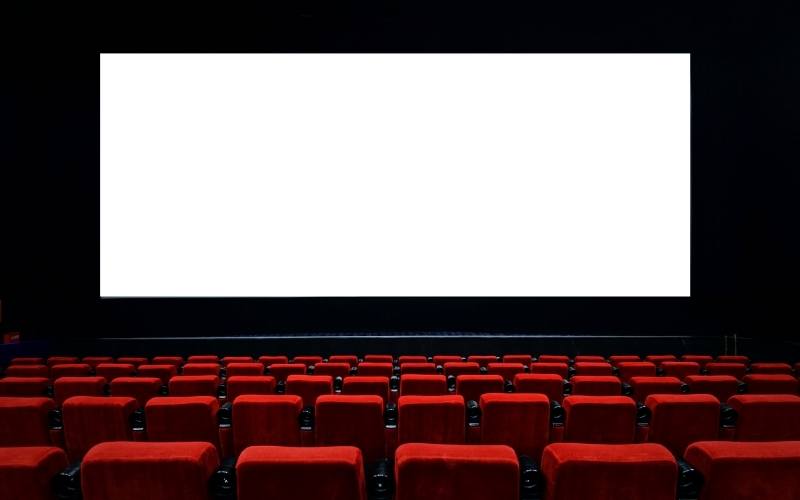What Kind of Projectors Do Movie Theaters Use? Everyone loves going to movie theaters to have a relaxing evening with friends. Many curious souls are often left wondering what kind of projectors do movie theaters use? Is it different from the home editions? Movie theater projectors create stunning visuals and even people sitting at a distance can see clear and detailed videos.
Industrial projectors are used for the best theatrical experience.
Regular projectors used for offices and homes can not project clear and crisp images on the screen.
Theater operators use commercial-grade projectors that are larger and heavier than standard projectors.
Movie Theater projector has a different working process, features, purchase price, and other aspects.
These are ultra-bright projectors with high resolution and a very large screen.
They are different from the normal projectors in many ways and deliver better performance at a higher level.
Without further ado, here’s what you should know about movie theater projectors.
What Kind of Projectors Do Movie Theaters Use?
Movie buffs want to know what is behind delivering these amazing, clear images. Well, High-end movie theater projectors are better performers for the job.
The projectors used in cinemas today and in the early days are completely different.
Now, movie theaters have gone completely digital so do the projectors to meet the demand for new digital formats.
Commercial projectors are larger and weigh hundred pounds more.
DLP (Digital Light Processing) projectors are used in theaters that have integrated DCP (Digital Cinema Projector) hardware for the cinema.
Film studios sell their films on licensed hard drives with limiting viewing times of the particular film.
DCP hardware ensures that the film is played within the restricting viewing period.
These projectors work on a simple working principle by responding to anti-piracy measurements and license restrictions of content without compromising performance.
What Kind of Projectors Do Movie Theaters Use? Technologies Used In DCP
DLP and SXRD are two technologies used in DCPs.
DLP (Digital Light Processing)
DLP has millions of silicon microscopes and each chip has a pixel to create a sharp image.
All pixels contribute to projecting a high-quality, in-depth image on the screen. It is also equipped with large lamps having high brightness.
Their light splits into the colors of the spectrum and is projected onto the right mirror.
The front lens combines separate beams of light to create a unified image to project on the big screen.
Silicon Crystal Reflective Display ( SXRD)
The light beam is divided into separate colors and falls at the reflective surface consisting of silicon crystals, resulting in producing a pixel of 4k resolution.
This technology is available in movie projectors having 4K resolution.

Features Of A Movie Theater Projector
As the movie theatre projector is meant to do a bigger job, so, understandably, it is going to have different features than the regular models.
Here are some of the amazing features this projector has.
Brightness
Theatre projectors are specifically crafted to have high brightness so that people sitting in the last row can see clearly.
Typically, these projectors have 25000 lumens of brightness whereas a standard model has approximately 3000 lumens. Worthy Old Movie projectors also include this brightness level.
So, there is a difference of about 22000 lumens. Since theater halls are large, hence a need for higher lumens to project a better image.
Resolution
High brightness and low resolution result in a blurry video. Therefore, theater projectors have a higher resolution as well, mostly 4K.
4K resolution projects a very high-quality image for audiences to enjoy. A regular projector usually offers a 1080p resolution. Modern Expensive projectors increase resolution level.
Screen Size
Large screens are used in cinemas and theaters, so, everyone in the audience can enjoy and see clearly.
Movie theater projectors project onto screens as large as 100 feet.
Contrast Ratio
These projectors have an enhanced contrast ratio of up to 6000:1.
Contrast is the difference between black and white, the more the difference, the more vibrant colors mixed with black will be seen on the screen.

High Frame Rate
A projector plays picture by picture as films are split into digital images.
Each image is played individually creating an illusion that it is a moving image when in actuality, it is not.
A faster frame rate makes the movie blurry, whereas, a high frame rate ensures a smoother transition of frames.
Cooling System
Large lamps generate a lot of heat, so, other parts heat up quickly even when kept at a low temperature.
Theater projectors boast a liquified cooling system along with fans to ensure the equipment does not overheat. That’s why these projectors are not recommended for home usage. Click here to read the best home usage selection.
The inner cooling system and fans release the extra heat out and lower the temperature of the power-intensive components. Read more to know how long Projectors last and the effect of the cooling systems on their age.
Price
The price is understandably higher than the regular projector.
Moreover, different accessories like hard disc, server, and other add-on capabilities increase the cost drastically.
The price range is between $10000 to $80000 because of the large size and the expensive components used in the manufacturing of this project.
Weight
These projectors are portable and weigh more than average human weight.
Their weight is about 140 KGs owing to the device’s size and the components packed inside them.
Other Special Features
Some special features are only present in movie theater projectors and not in any other model.
Command or control the projector over the web with the help of the web control interface.
The automation capability is unique to cinema projectors allowing the operator to set the sequence of events, the scheduled time, and the projector will do the job by itself.
Brands Manufacturing Movie Theater Projectors
Many projector manufacturing companies fail to meet the requirements due to the strict standards set by DCI.
Only four brands Barco, Christie, NEC, and Sony provide the picture quality assurance as per the standards.
Barco, Christie, and NEC incorporate DLP technology whereas Sony utilizes SXRD technology.
Theaters have heavy, power-intensive projectors with special features to give the best cinematic experience.
These projectors have enormous screens, high brightness, better resolution, and an efficient cooling system.
DLP is the commonly used technology in most cinema projectors.
These projectors are designed to provide a better viewing experience to people buying tickets to watch a movie in a theater.
FAQs: What Kind of Projectors Do Movie Theaters Use
Which projector is used in Theatres?
The projectors commonly used in movie theaters are high-end digital projectors known as Digital Cinema Projectors (DCPs). These projectors offer exceptional image quality and are designed to meet the high standards of the cinematic experience, including resolutions like 2K or 4K for sharp, vibrant, and immersive visuals.
Do movie Theatres use projectors?
Yes, movie theaters primarily use projectors to display films on the big screen. These projectors are specifically designed for cinematic use, offering high-quality visuals and precise color reproduction to provide audiences with a compelling and immersive viewing experience.
Do theaters have 4K projectors?
Many modern theaters have adopted 4K projectors, which offer incredibly sharp and detailed visuals. These projectors enhance the cinematic experience by delivering high-resolution images that are especially impressive on the big screen.
What do movie theaters use to project movies?
Movie theaters use specialized digital projectors to display films. These Digital Cinema Projectors (DCPs) are designed to meet the high standards of the cinematic experience, offering exceptional image quality and precise color reproduction on the big screen.
Conclusion: What Kind of Projectors Do Movie Theaters Use?
What Kind of Projectors Do Movie Theaters Use? In conclusion, movie theaters rely on specialized Digital Cinema Projectors (DCPs) to deliver the stunning visual experience that captivates audiences. These high-quality projectors, often operating at 2K or 4K resolutions, ensure sharp and vibrant images on the big screen. The technology behind these projectors plays a pivotal role in bringing the magic of cinema to life, offering viewers an immersive and unforgettable cinematic journey.
